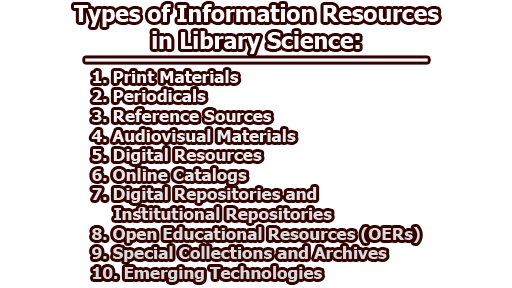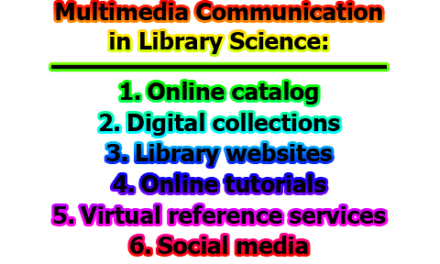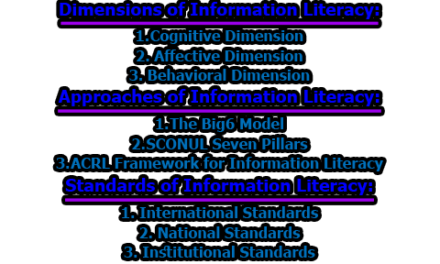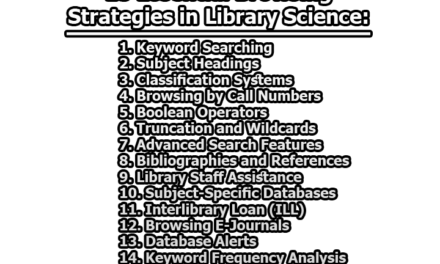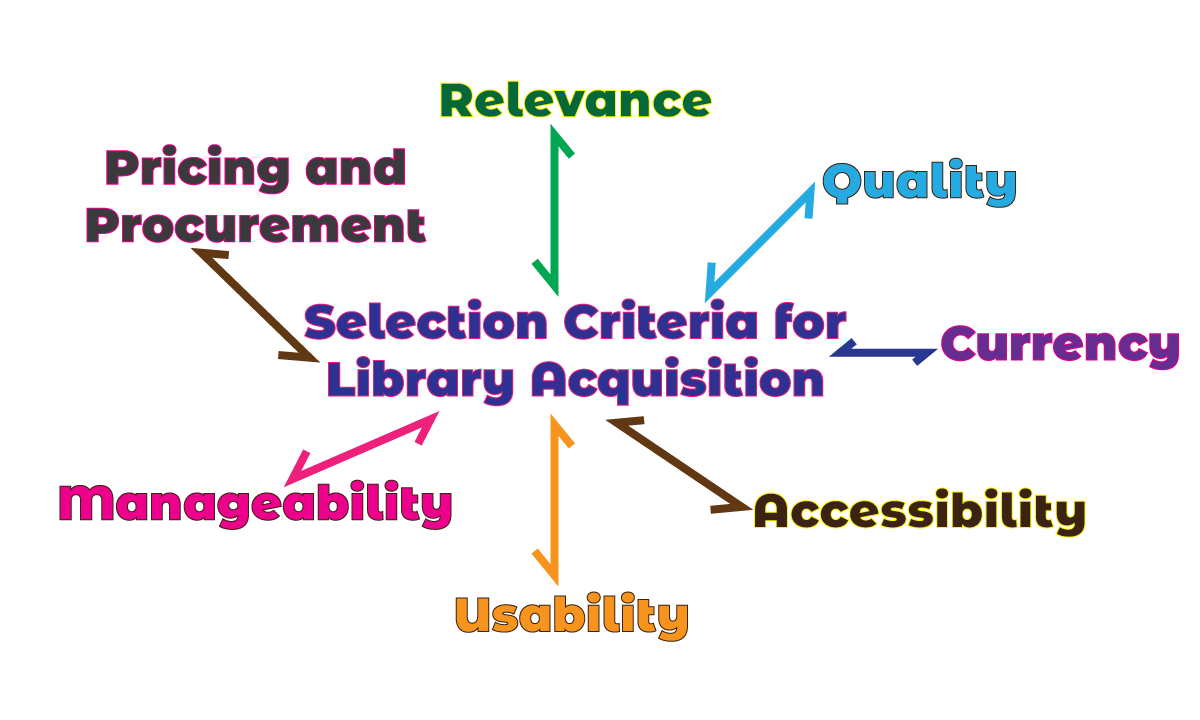Types of Information Resources in Library Science:
Information resources play a crucial role in the field of library science. These resources are essential for libraries to meet the diverse information needs of their users, support research and learning, and contribute to the overall development of individuals and communities. In this article, we will explore various types of information resources found in library science, ranging from traditional print materials to digital resources and emerging technologies.
1. Print Materials: Print materials have long been the backbone of library collections. They encompass a wide range of formats, including books, journals, newspapers, magazines, and pamphlets. Print materials offer several advantages, such as portability, durability, and ease of access. They provide in-depth information on various subjects and are particularly valuable for in-depth research and study. Libraries acquire print materials through purchases, donations, or interlibrary loan programs.
2. Periodicals: Periodicals refer to publications issued at regular intervals, such as weekly, monthly, quarterly, or annually. They include scholarly journals, popular magazines, newspapers, newsletters, and bulletins. Periodicals are crucial for staying updated with current information, research findings, news, and trends. Libraries often maintain subscriptions to a diverse range of periodicals, providing users with access to a wide array of specialized knowledge.
3. Reference Sources: Reference sources are concise, authoritative works that provide quick access to specific information. These sources include encyclopedias, dictionaries, atlases, almanacs, directories, and handbooks. Reference sources are invaluable for answering factual queries, providing background information, and gaining a general understanding of a topic. They are frequently used in reference sections within libraries and are not typically available for loan.
4. Audiovisual Materials: Audiovisual materials refer to non-print resources that incorporate both visual and auditory components. They include DVDs, CDs, audiobooks, videotapes, microforms, slides, and photographs. These materials cater to different learning styles, enhance engagement, and provide opportunities for visual and auditory exploration. Libraries often have audiovisual departments or multimedia sections that house and circulate these materials.
5. Digital Resources: With the advent of digital technologies, libraries have witnessed a significant shift in the type of information resources they offer. Digital resources include electronic books (e-books), electronic journals (e-journals), databases, online reference sources, multimedia materials, and web-based resources. These resources provide remote access, advanced search capabilities, and instant availability of information. Libraries often subscribe to digital databases and offer access to e-books and e-journals to meet the changing needs of their users.
6. Online Catalogs: Online catalogs, also known as library catalogs or OPACs (Online Public Access Catalogs), are computerized databases that allow users to search for resources available within a library’s collection. Online catalogs provide information about the location, availability, and bibliographic details of books, journals, audiovisual materials, and other resources. They enable users to perform keyword searches, browse through subject headings, and check the availability of materials. Online catalogs have significantly improved the efficiency of library operations and the overall user experience.
7. Digital Repositories and Institutional Repositories: Digital repositories are online platforms that store, preserve, and provide access to digital content. These repositories house a wide range of resources, including research papers, theses, dissertations, reports, datasets, multimedia materials, and other digital objects. Institutional repositories, in particular, focus on preserving and disseminating the scholarly output of an institution. They play a crucial role in promoting open access to research and facilitating knowledge sharing among researchers and the wider community.
8. Open Educational Resources (OERs): Open Educational Resources are freely accessible educational materials that can be used, modified, and shared by educators and learners. OERs include textbooks, lecture notes, lesson plans, videos, interactive modules, and assessments. Libraries contribute to the adoption and promotion of OERs by curating and providing access to these resources. They support affordable and inclusive education by reducing the financial burden on students and enhancing the availability of high-quality learning materials.
9. Special Collections and Archives: Special collections and archives consist of unique and rare materials that require special care and preservation. These collections may include manuscripts, rare books, maps, photographs, artwork, historical documents, audio recordings, and artifacts. Special collections and archives offer valuable insights into specific subjects, historical events, or cultural heritage. Libraries often collaborate with scholars, researchers, and cultural institutions to curate and showcase these collections, ensuring their long-term preservation and accessibility.
10. Emerging Technologies: Libraries are increasingly adopting emerging technologies to expand the range of information resources available to their users. These technologies include virtual reality (VR), augmented reality (AR), 3D printing, maker spaces, and robotics. VR and AR technologies can provide immersive and interactive learning experiences. 3D printing allows users to create physical objects based on digital designs. Makerspaces offer access to tools, equipment, and resources for hands-on learning and creative projects. Robotics introduces users to programming, automation, and artificial intelligence. These emerging technologies contribute to the evolving nature of libraries and the resources they provide.
In conclusion, the field of library science encompasses a diverse range of information resources. From traditional print materials to digital resources and emerging technologies, libraries strive to meet the information needs of their users in a rapidly changing information landscape. By offering a comprehensive and varied collection of resources, libraries support research, learning, and the overall intellectual growth of individuals and communities.
FAQs:
How do I find books in a library?
To find books in a library, you can use the library’s online catalog or OPAC (Online Public Access Catalog). Simply search for the book title, author, or subject keywords to locate the desired books. The catalog will provide information on the availability, location, and call number of each book.
How can I access digital resources from a library?
Most libraries provide access to digital resources, such as e-books, e-journals, and databases, through their websites. You may need a library card or login credentials to access these resources remotely. Libraries often offer instructions or tutorials on their websites to guide users in accessing and using digital resources.
What is an interlibrary loan and how does it work?
Interlibrary loan (ILL) is a service offered by libraries to obtain materials from other libraries that are not available in their own collections. Users can request books, articles, or other resources through ILL, and the library will try to borrow them from another library. The requested materials are then made available to the user for a specified period. There may be charges or restrictions associated with interlibrary loan services.
How do libraries handle copyright issues?
Libraries adhere to copyright laws and regulations to ensure the legal use and distribution of copyrighted materials. They often obtain licenses and subscriptions to provide access to digital resources. Libraries also educate users about copyright compliance and fair use guidelines. In some cases, libraries may have specific policies regarding the copying or reproduction of materials for research or educational purposes.
Can I access library resources remotely?
Yes, many libraries provide remote access to their resources through online platforms. Users can often access digital resources, online catalogs, and other library services from anywhere with an internet connection. Libraries may require users to authenticate themselves with a library card or login credentials to ensure authorized access.
How can libraries support research and information literacy?
Libraries support research and information literacy by offering a variety of resources and services. They provide access to scholarly journals, databases, reference sources, and specialized collections. Librarians offer research assistance, guidance in locating relevant resources, and instruction on information literacy skills such as evaluating sources and conducting effective searches. Libraries may also organize workshops, seminars, and training sessions to enhance research skills.
How are libraries adapting to digital technology?
Libraries are adapting to digital technology by embracing digital resources, online catalogs, and digital repositories. They are incorporating emerging technologies such as virtual reality, maker spaces, and 3D printing to provide innovative and interactive learning experiences. Libraries are also implementing automated systems for circulation, cataloging, and resource management to streamline operations and improve user services.
Can I borrow materials from other libraries if I am not a member?
Interlibrary loan services may be available to non-members of a library, but it depends on the policies of the individual library. Some libraries extend interlibrary loan privileges to non-members for a fee, while others restrict the service to their own members. It is best to contact the library directly to inquire about their interlibrary loan policies for non-members.
References:
- Rubin, R. E. (2014). Foundations of library and information science. Neal-Schuman Publishers.
- Bopp, R. E., & Smith, L. C. (2011). Reference and information services: An introduction. Libraries Unlimited.
- Matthews, J. R. (2014). The impact of technology on library collections and services. Library Technology Reports, 50(7), 1-55.
- Chowdhury, G. G., & Chowdhury, S. (2007). Introduction to digital libraries. Facet Publishing.
- Borgman, C. L. (2000). From Gutenberg to the global information infrastructure: Access to information in the networked world. MIT Press.
- Lesk, M. (2005). Understanding digital libraries. Morgan Kaufmann.
- Buckland, M. K. (1992). Redesigning library services: A manifesto. American Library Association.
- Bell, S. J. (2009). Digital libraries: Principles and practices in a global environment. Neal-Schuman Publishers.
- Lancaster, F. W. (2003). If you want to evaluate your library… (2nd ed.). Information Today.
- Dempsey, L. (2005). The librarian’s challenge: Rethinking the nature of the library in the post-Web world. Library Trends, 54(2), 178-196.

Former Student at Rajshahi University

